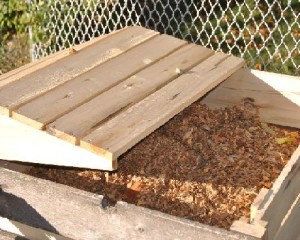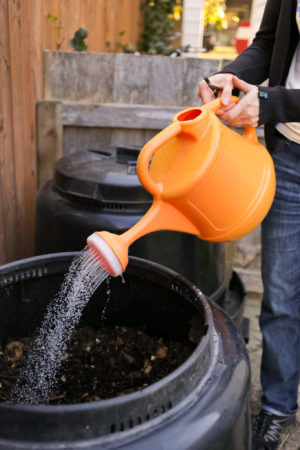If you haven’t started composting yet, head here to get started! Spring is a great time to start composting, and if you’re lucky, you may even have some finished compost by fall (or at least by next fall…a key ingredient for compost is time!).
For those of you who have compost bins that are starting to thaw out, here’s a few spring maintenance tips to get you ready for gardening season!
Thank the Cold
The best part of having your compost sit outside through our frigid Manitoba winters is that your compost freezes! Yes, that’s actually helpful, even though almost no active decomposition was happening while it was -20 outside. Organic materials that freeze become much softer once they melt, due to the water in the cells expanding and bursting the cell walls. This means that anything that’s been frozen will decompose faster after it thaws! Thanks, winter, for doing some of the work for us.
Consider Harvesting
If you didn’t get around to it in the fall, and your bins are full, take a look inside to see if you have enough finished compost to harvest it. Starting off with a relatively empty bin means you’ll have more room to add through the summer! Remember finished compost will generally be at the bottom of a bin or heap, so you’ll have to move around any unfinished material on top and then replace it once you’re done harvesting. If you have a raised tumbler-style bin, avoid harvesting finished compost from it until the entire bin contains finished compost (this is one reason why you’ll want to have two bins if you choose this style).
Starting off with a relatively empty bin means you’ll have more room to add through the summer! Remember finished compost will generally be at the bottom of a bin or heap, so you’ll have to move around any unfinished material on top and then replace it once you’re done harvesting. If you have a raised tumbler-style bin, avoid harvesting finished compost from it until the entire bin contains finished compost (this is one reason why you’ll want to have two bins if you choose this style).
If you harvested your compost, you’ll want to use it! If you’re applying it to an area that will have seeds or new seedlings, try to apply the compost to the soil as far before planting as possible, to be sure the compost is completely mature. Otherwise, it’s great to spread on your lawn, or at the base of mature trees and shrubs!
 Don’t Forget Your Browns
Don’t Forget Your Browns
If you kept adding to your compost bin through the winter, and chose not to layer in order to save space, that’s awesome! However, that means your nutrient balance will be off, and you need to add enough browns to balance it back out. Hopefully you still have a nice pile of dried leaves stored up from last fall. Ran out of leaves? Other good sources of “browns” include clean sawdust or fine wood shavings; shredded office paper or newsprint (nothing glossy, please!); and paper towels, in a pinch (they’re a bit awkward to deal with but do break down ok). The rule of thumb is for every 1 pound of ‘greens’ (kitchen scraps and high nitrogen items), add 1 pound of ‘browns’ (carbon-rich materials). The ratio by volume is usually 1 bucket of kitchen scraps to 2-3 buckets of dried leaves; or 1 bucket of greens to 1 bucket of sawdust (sawdust is much denser and has more carbon by weight than dried leaves do, so you may be able to drop the ratio even further).
Check Moisture

First thing in spring, many compost piles will be quite wet. That’s natural, but note that if it stays really wet, you may struggle with smell problems. Most piles will dry out on their own, and will actually need you to actively ADD water! A dry compost pile is a slow compost pile – the microorganisms that break down your organics need water to be happy and do their hard work.
Let Nature Do The Rest!
Remember, decomposing is a natural process that will happen whether you want it to or not – hence why many of us have soggy lettuce at the back of our fridges (check out our food waste reduction tips here, because nobody likes soggy lettuce!). All our compost tips are aimed at helping you get a better product, with fewer issues, faster…but no matter what you do, you can’t help but make compost eventually! Once you’ve balanced out your bin’s greens with some browns and given it a stir, sit back and relax and let nature do the rest.
Happy Composting!




looking forward to more info!
Hi Lorraine,
We’d love to help you get the info you’re looking for! What are you hoping to learn more about? We have a lot of posts on our website, as well as a series of compost themed webinars coming up the first week of May. You can always reach out too at compost (at) greenactioncentre.ca with any questions!
Good info!
If using sawdust as browns ensure it’s not from chemically treated rot resistant wood otherwise you would have poisonous compost- not healthy in the garden as vegetables grown in such soil would be toxic.
What about dried, brown grass rakings from your spring lawn to add as ‘browns’? Would this be considered browns or still as high nitrogen material?
What about spruce needle material as browns- is it too acidic or to hard to compost?
What about adding ashes from your fire pit to the composter- does it help or hinder the process?
I find egg shells and peanut husks break down very/too slowly in the composter. I now transform them to dust in my food processor before adding to the composter- I assume this would be considered a brown material.
Thanks for the thoughts and great questions, Rick!
Sawdust should definitely be from clean, untreated wood, and not from plywood or particle board/MDF etc as there’s a lot of glues and the like in that which aren’t very compost friendly.
Grass clippings once dry and brown are a great browns source for your compost! We always encourage folks to “grasscycle” and leave clippings on the lawn, but if you end up with a pile of clippings, they’re totally compostable. Fresh green ones are full of nitrogen and great for speeding up a slow compost! Once they really dry out, they lose a lot of nitrogen and become carbon-heavy.
Spruce needles – they DO compost, but they have a waxy coating and take forever. They’re also very dry. I would only add those, personally, if I had a very slow pile I didn’t expect to harvest for several years. The acidity of the needles wouldn’t be an issue if they compost fully, but if they’re not fully broken down, may cause the compost to be more acidic than you’d like.
Wood ash is ok in small amounts in a compost bin. If it combines with water and fat however, you may accidentally end up with lye, so be sure that if you’re adding ashes you’re keeping fat out of the bin (something you probably want to do anyway, unless you have a very hot active pile)
Eggshells aren’t really a green or a brown – more of just a straight calcium source. Pulverizing them is a good plan. Peanut shells would be a brown, yes – and they sure do compost slowly! Turning them to dust makes sense. Other slow composters include sticks, avocado pits, corn cobs, etc. There’s no problem with throwing them in, but you may choose to harvest your compost and just throw back in such woody items to be harvested another year. Generally, anything that’s very slow to break down is a “brown”.